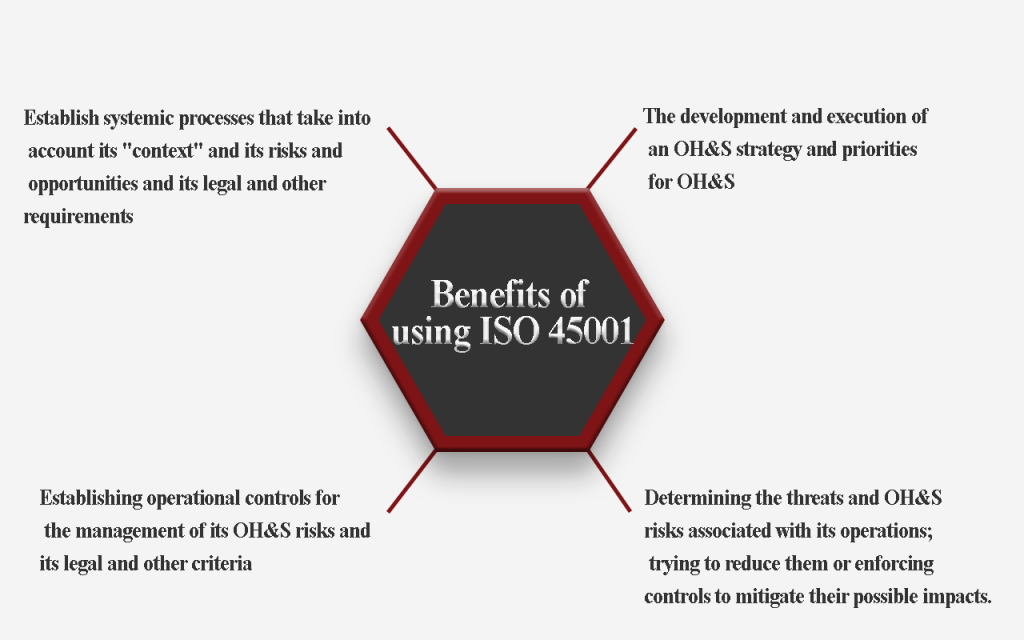Employees are the driving force for your organizational development, and without them you cannot achieve your goals. Maintaining a healthy work environment is essential to maintain the health of your employees so that they will be more willing to work.
ISO 45001: 2018 is the key to doing this; it helps organizations improve Occupational Health and Safety (OHS) by eliminating risks and reducing worker-related risks. As well as related health impacts in the long run. This system provides an approach on how to develop a safety culture within your organization by following the ISO standard and involving the employees in identifying business process risks. This will lead to an increase in the loyalty of employees and employee retention, which will result in an increase in the productivity. In addition, ISO 45001: 2018 assists in the evaluation of products/services supplied that may have an impact on the occupational health and safety.
What is ISO 45001:2018?
ISO 45001:2018 is a global standard that specifies requirements for occupational health and safety management systems (OH&S). It sets out guidelines for its use to encourage organizations to provide safe and healthy workplaces by preventing occupational injuries and ill health, as well as by proactively enhancing OH&S performance. As such, it provides a practical approach to improve the safety and health of staff and others. This standard has been established with the intention of applying it to any organization, irrespective of its size, type and nature.
Why ISO 45001:2018?
Employees are the driving force for your organizational development, and without them, you cannot achieve your goals. Maintaining a healthy work environment is essential to maintain the health of your employees so that they will be more willing to work.
ISO 45001:2018 is the key to doing this; it helps organizations improve Occupational Health and Safety (OHS) by eliminating risks and reducing worker-related hazards. As well as related health impacts in the long run. This system provides an approach on how to develop a safety culture within your organization by following the ISO 45001 standard and involving the employees in identifying business process risks. This will lead to an increase in the loyalty of employees and employee retention, which will result in an increase in the productivity. In addition, ISO 45001:2018 assists in the evaluation of products/services supplied that may have an impact on the occupational health and safety.
What is ISO 45001 Methodology?
The basis for the methodology underpinning the environmental management framework is the Plan-Do-Check-Act principle (PDCA). The PDCA model presents a quality improvement process used by companies, which can be extended to any of the elements of an environmental management framework.
PDCA model is as follow:
⦁ Plan: develop OHS objectives and procedures needed to produce results in line with the company’s OHS policy.
⦁ Do: Implement the planned the procedures.
⦁ Check: monitor and review environmental policy processes, including commitments, OHS goals and organizational requirements, and report on outcomes.
⦁ Act: take an action to continually improve.
Duration of getting ISO 45001 certification.
ISO 45001 certification is a progressive loop, not a single function, and is in accordance with the requirements of important international standards. ISO 45001 certification can be obtained within 1 week from UCS. The duration includes the registration and the certification audit.
What are the benefits of having a formal certified health and safety management system?
It is important to have a formal health and safety management system in your organization because a safe and healthy workplace protects workers from injury and disease and reduces the cost of injury/illness. In this way, health and safety performance in your organization will be improved. Also, the system improves awareness of legal requirements, which enhances compliance with legislation and regulations. Moreover, it improves productivity and quality and increases the morale of employees because employees take into consideration the care provided for their health and safety.
Benefits of using ISO 45001?
- The development and execution of an OH&S strategy and priorities for OH&S
- Establish systemic processes that take into account its “context” and its risks and opportunities and its legal and other requirements
- Determining the threats and OH&S risks associated with its operations; trying to reduce them or enforcing controls to mitigate their possible impacts.
- Establishing operational controls for the management of its OH&S risks and its legal and other criteria

you can read BENEFITS OF ISO CERTIFICATION IN UAE to understand more about benefits of ISO certification
also you can check International Organization for Standardization to find more information about ISO 45001:2018

